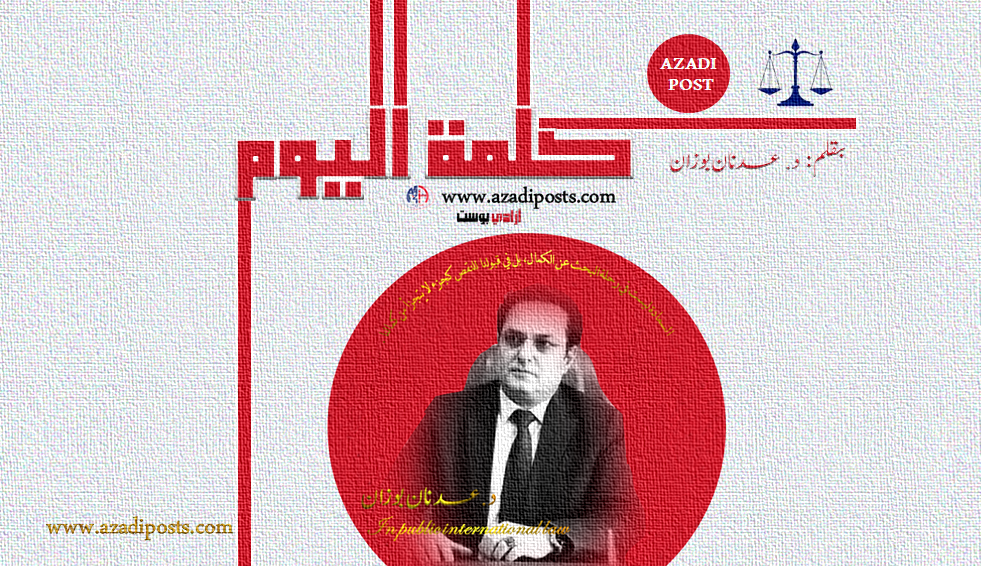The Middle East in the Eye of the Storm: A War to Redraw Maps... and the Beginning of the End for the Old State
- Super User
- Word of the Day
- Hits: 3399

By Dr. Adnan Bozan
At this critical and volatile moment—where missiles intersect with political decisions and frontlines entangle with global interests—the Middle East once again finds itself standing on the brink of history. No longer merely a burning geography, the region is becoming the largest laboratory for producing new maps out of the ashes of collapsed states.
Another war is added to the endless ledger of unresolved conflicts.
But this war is different—it is not simply an armed clash between two sides. It is a grand battle that marks the end of one era and the beginning of another.
It is the public implementation of the "New Middle East" map—not in ink, as it was once sketched in foreign offices, but in blood, destruction, and delayed decisions now imposed by force.
The Iran–Israel War: From the Shadows to Open Explosion
In recent days, an open confrontation erupted between Iran and Israel, surpassing the limits of the shadow conflicts that have been quietly waged for years.
This is no longer a mere proxy war waged by militias stretching from Yemen to Lebanon. It has become a direct confrontation targeting cities, military centers, and vital strategic infrastructure.
This is a comprehensive regional conflict, rolling toward a major war that threatens the entire regional order, reshapes alliances, and redraws the map of political and military influence in the Middle East.
Cities are being heavily bombarded. Power grids, airports, military bases, and Iranian command centers in Tehran, Syria, and Iraq are being systematically destroyed.
With broad intelligence and technical support, Israel is attempting to deliver precise blows to the core of Iran’s regional project, while Iran responds with conventional and ballistic missile strikes—both directly and through its widespread proxies across the region.
The United States: Before the Storm… and a Delayed Entry
As of the time of writing, the United States has not officially entered the war. However, all political and military indicators suggest that its involvement is imminent—perhaps only hours or days away.
Naval deployments, elevated readiness at U.S. bases in the Gulf, and emergency meetings in the Pentagon all point to a decision that has already been made. What remains is determining the appropriate timing and operational context.
This is not viewed merely as support for America's ally, Israel, but rather as a deeper strategic step: a practical implementation of an old-new plan aimed at dismantling centers of power in the Middle East and constructing a new regional system on the ruins of centralized states—just as happened in Iraq, and as Iran now appears to be heading toward.
The "New Middle East": From Paper Maps to Bloody Borders
For more than two decades, the "New Middle East" project has been promoted as a vision that transcends the outdated Sykes–Picot borders. Its goal: to fragment major states and transform them into sectarian, ethnic, or nationalist entities in perpetual conflict.
The ongoing war is not a mere reaction to an incident or escalation—it marks the actual beginning of this project’s fiery and violent implementation on the ground:
- The fragmentation of Iran would signal the fall of the last coherent central state in the region, following Iraq and Syria.
- Iraq is again at risk of plunging into chaos, given its fragile sectarian and political balance.
- Syria, hollowed and exhausted, will serve as a corridor and battleground for multiple fronts.
- Lebanon is poised for internal collapse if Hezbollah escalates its involvement.
- Yemen will be used as a pressure card against the Gulf through the Tehran-aligned Houthis.
- And the Gulf states will no longer remain safe, amid growing threats to oil infrastructure and strategic maritime passages.
After the War... What Remains of the State?
This is not a war between conventional armies—it is a comprehensive assault on the very concept of the "nation-state" in the Middle East.
With each modern war, the state emerges weaker, society more divided, and national identity increasingly fragile.
We are facing a long-term fragmentation project—not one that produces peace, but one that cultivates a chronic chaos to be strategically exploited by global powers.
Should Iran fall as a centralized state, what will emerge is not democracy, but a mosaic of micro-states: Kurdish, Azeri, Balochi, Arab, and isolated Persian regions.
And when the last pillars of centralized authority collapse, the entire region becomes vulnerable to internationalization—where sovereignty is transferred from national capitals to operation rooms in Washington, Tel Aviv, and Moscow.
What Is to Be Done? Where Is the Voice of Reason?
In the age of missiles, wisdom falters. In the roar of warplanes, the voice of reason is barely a whisper.
But we must ask: Is there still room for a grassroots project to rise from within the region’s peoples—one not founded on arms, but on consciousness, vision, and shared responsibility?
Can a new Middle East be born—not from under the rubble, but from the inner will of its people—on foundations of justice, freedom, dignity, and democracy?
The Middle East is being reshaped today, against the will of its own nations.
Yet history has taught us that peoples who collapse do not necessarily die.
Beneath the ashes, there is always an ember waiting for a clean wind to ignite it again.
Will this war be the beginning of the end?
Or will it mark the rebirth—out of the wreckage—of something radically new?


